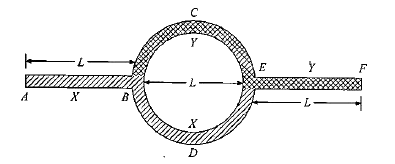Figure shows an aluminium rod joined to a copper rod. Each of the rods has a length of 20cm and area of cross section 0.20cm2 . The junction is maintained at a constant temperature 40∘C and the two ends are maintained at 80∘C . Calculate the amount of heat taken out from the cold junction in one minute after the steady state is reached. The conductivities are KAl=200Wm−1C−1 . and KCu=400Wm−1C−1 .
 Solution in Tamil
Solution in Tamil
The correct Answer is:A, D
KAl=200W/m∘C,
KU=400W/m∘C,
A=0.2cm2=2×10−5m2
l=20cm=2×10−1m
Heat drawn per sec.
QAl+QCu=KAl×A×(80−40)l
+(K_(Cu)xxAxx(80-40))/l<br≥2×10−5×402×10−1[200+400]
=2.4J.
Heat drown per minute =2.4xx60=144J.
Topper's Solved these Questions
Similar Questions
A centigrade and a Fahrenheit thermometer are dipped in boiling water. The water temperature is lowered until the Fahrenheit thermometer registered at 140°F. What is the fall in temperature as registered by the centigrade thermometer ?
View SolutionThe steam point and the ice point of a mercury thermometer are marked as 80∘C and 20∘C. What will be the temperature in centigrade mercury scale when this thermometer reads 32∘C?
View SolutionFind the dimensions of
a. linear momentum
b. frequency and
c. pressure
View SolutionThree rods of lengths 20cm eac h and area of cross section 1cm2 are joined to from a triangle ABC. The conductivites of the rods are kAB=50Js−1m−1(@)C^(-1),k_(BC)=200Js^(-1)m^(-1)(∘)C−1 , and kAC=400Js−1m−1(@)C^(-1).ThejunctionA,BandCarema∫a∈edat40^(@)C,80^(@)Cand80^(@)C respectivelt. Find the rate of heat flowing through the rods AB, AC and BC .
View SolutionThe ends of a copper rod of length 1m and area of cross-section 1cm^2 are maintained at 0^@C and 100^@C . At the centre of the rod there is a source of heat of power 25 W. Calculate the temperature gradient in the two halves of the rod in steady state. Thermal conductivity of copper is 400 Wm^-1 K^-1 .
View SolutionTwo ends of a conducting rod of varying cross-section are maintained at 200^(@)C and 0^(@)C respectively. In steady state:
View SolutionThree rods of copper, brass and steel are joined together to form T shape as shown in figure. The cross sectional area of each rod is 4cm^(2) the end of copper rod is maintained at 10^(@)C and the ends of brass and steel rods at 0^(@)C assume there is no loss of heat to surrounding. What is temperature of junction point A in .^(@)C
View Solution(a) Three rod of lengths 20cm each and area of cross-section 1cm2 are joined to form a triangle ABC. The conductivities of the rods are KAB=50J/m−s−.∘C,KBC=200J/m−s−.∘C and KAC=400J/m−s−.∘C. The junctions A,B and C are maintained at 40∘C, 80∘C and 80∘C respectively. Find the rate of heat flowing through the rods AB,AC and BC.
(b) A semicircular rod is joineted as its end to a straight rod of the same material and the same cross-sectional area. The straight rod forms a diameter of the other rod. The junctions are maintained at different temperatures. Find the ratio of the heat transferred through a cross-section of the simicircular rod to the heat transferred through a cross-section of the straight rod in a given time.
View SolutionFigure shows a steel rod joined to a brass eod. Each of the rods has length of 31cm and area of cross-section 0.20cm2. The junction is maintained at a constant temperature 50∘C and the two ends are maintained at 100∘C. The amount of heat taken out from the cold junction in 10 minutes after the steady state is reached in n×102J. Find 'n' the thermal conductivities are Ksteel=46W/m−∘C and Kbrass=109W/m−∘C.

View SolutionTwo rods of material, x and two of y are connected as shown in the figure. All the rods are indentical in length and cross-sectional area. If the end A is maintained at 80^(@)C and the end D is maintained at 10^(@)C , calculate the temperature of the junctions B and C in the steady state. Thermal conductivity of x is double that of y .
View SolutionTwo rods of copper and brass having the same length and cross - section are joined end to end. The free end of the copper is at 0^(@)C and of brass is at 80^(@)C in steady-state. If thermal conductivity of copper is 4 times of that of brass find the temp. at junction of two rods
View SolutionTwo rods A and B of different materials but same cross section are joined as in figure. The free end of A is maintained at 100°C and the free end of B is maintained at 0°C. If l_2=2l_1,K_1=2K_2 and rods are thermally insulated from sides to prevent heat loses then the temperature theta of the junction of the two rods is
View SolutionFew rods of material X and Y are connected as shown in figure - 4.10. The cross sectional area of all the rods are same. If the end A is maintained at 80∘C and the end F is maintained at 10^(@)C~ . Calculate the temperatures of junctions B and E in steady state . Given that thermal conductivty of material X is double that of Y.

View SolutionTwo rods of similar area of cross section and length are joined as shown in the figure. The ratio of their thermal conductivity is 2:3. The free ends are maintained at 100∘C and 0∘C respectivley. THE temperature at junction in steady state is

View SolutionA large cylindrical rod of length L is made by joining two identical rods of copper and steel of length (L2) each. The rods are completely insulated from the surroundings. If the free end of copper rod is maintained at 100∘C and that of steel at 0∘C then the temperature of junction is (Thermal conductivity of copper is 9 times that of steel)
View SolutionThree rods of lengths 20cm each and area of cross section 1cm2 are joined to from a triangle ABC. The conductivities of the rods are kAB=50Js−1m−1C−1 , kBC=200Js−1m−1C−1 , and kAC=400Js−1m−1C−1 . The junction A,B and C are maintained at 40∘C , 80∘C and 80∘C respectively. Find the rate of heat flowing through the rods AB, AC and BC .
View Solution
